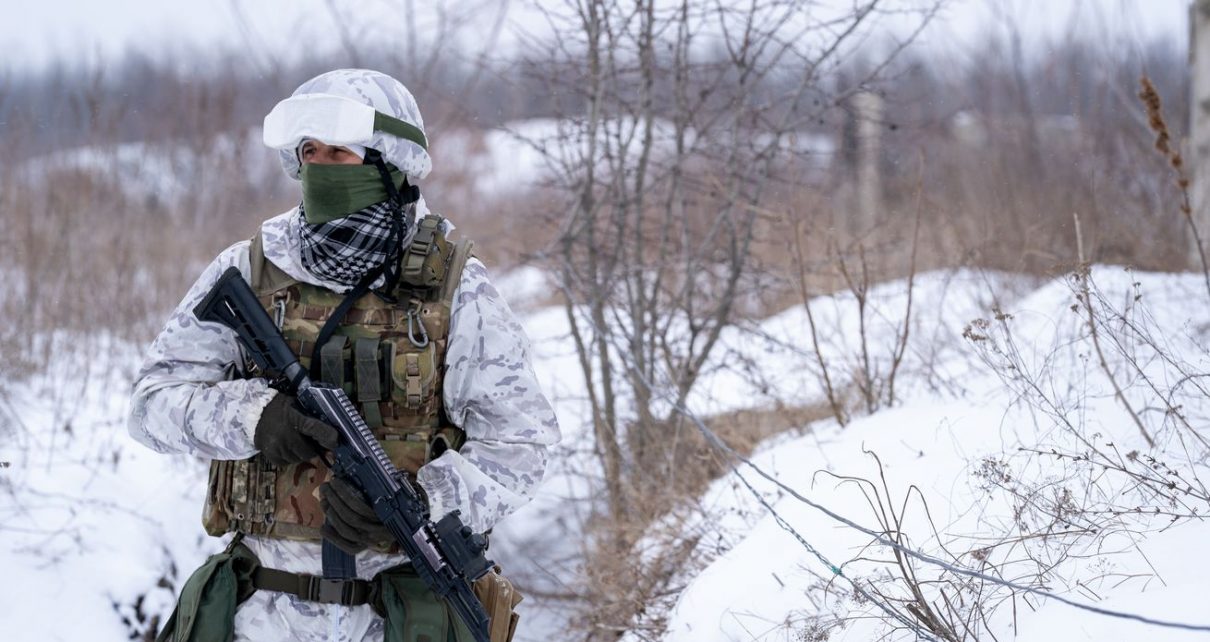
People are trying not to panic, but preparing for conflict.
With tensions between Russia and the West increasing and as many as 130,000 Russian troops massed on its borders, Ukraine is facing an increasingly difficult situation — trying to prepare for the worst while living with the uncertainty of what Russia will ultimately decide to do.
That uncertainty has only been heightened by a major gap between US warnings about an invasion and Ukraine’s determination not to panic in the face of aggression — whatever that may look like.
US officials warned Sunday that a Russian attack could be imminent, and the US — along with Canada, Germany, and the United Kingdom — has ordered diplomats stationed in the Ukrainian capital of Kyiv to depart the city.
On Thursday, the State Department also warned that US citizens still in Ukraine should leave the country immediately, and the Pentagon on Saturday pulled US military trainers out of the country, relocating them “elsewhere in Europe,” according to spokesperson John Kirby. The US has reiterated that a Russian invasion of Ukraine would result in major sanctions against Russia’s financial system.
But while there have been worrying developments in recent days, particularly in Belarus and the Black Sea, a full-scale invasion hasn’t yet come to fruition, and for weeks now, in a sharp departure from US statements, Ukrainian leadership has been urging calm on all sides — and saying their assessment of the situation doesn’t match that of the US.
“There are no tanks in the streets,” Ukrainian President Volodymyr Zelensky said late last month. “But media give the impression, if one is not here, that we have a war, that we have army in the streets … That’s not the case. We don’t need this panic.”
Zelensky isn’t buying the US warnings.
“Today, the best friend for enemies is panic in our country, and all this information, which only helps panic, does not help us. There is too much information about deep full-scale war… Even the relevant dates are already being said.”
— max seddon (@maxseddon) February 12, 2022
Others involved in Ukrainian politics have also expressed dismay. “I am very pro-western, but the way this invasion news is coming out reminds me of [unverified rumors on] Russian Telegram channels, about unnamed sources and backroom information,” an anonymous former member of the Ukrainian Parliament told the Guardian this month.
That might be the point, Donald Jensen, director for Russia and Europe at the US Institute of Peace, told Vox. “Washington’s messaging has caused Russian confusion,” Jensen said, telling Vox that Russian officials have been off their game in diplomatic discussions in recent weeks. “Once you puncture the Kremlin bullshit … every day is a different propaganda line,” Jensen said of changes in Russian negotiating tactics, including, most recently, a demand that Ukraine deal directly with Donetsk and Luhansk, two breakaway regions in eastern Ukraine where fighting between pro-Russia separatists and the Ukrainian military has continued since 2014.
“We’re probably more calm than some people in the West”
In Ukraine, the prospect of a Russian invasion has provoked a surge of nationalism; in recent weeks, demonstrations have been going on throughout the country in support of Ukrainian independence.
On Saturday, according to Reuters, Ukrainians turned out for a massive demonstration in Kyiv, with thousands of people carrying banners with messages like “Ukrainians will resist,” and “Invaders must die,” and waving Ukrainian flags.
/cdn.vox-cdn.com/uploads/chorus_asset/file/23239287/1238408857.jpg) Sergei Supinsky/AFP via Getty Images
Sergei Supinsky/AFP via Getty ImagesAs Al Jazeera pointed out on Saturday, the protest was a dramatic show of solidarity, reminiscent of the 2014 Euromaidan protests when Ukrainians fought back against a corrupt pro-Russian regime in support of democracy.
“We are here to show that we are not afraid,” one protester, Nazar Novoselsky, told Al Jazeera, while another echoed Zelensky’s warning against panicking. “Panic is useless,” student Maria Shcherbenko said Saturday. “We must unite and fight for independence.”
Some citizens are making contingency plans; according to a recent Wall Street Journal report by James Marson, gun sales in Kyiv have increased, as have enrollments in first-aid courses. Many businesses and individuals are prepared to head to Lviv, a city in western Ukraine farther from the front lines of a potential invasion; “The whole country is going to Lviv,” Tetyana Kryva, a resident of Kyiv, told Marson. “It will be full.”
“It’s difficult to say, certainly, people are not panicking and trying to lead their ordinary lives,” Volodymyr Yermolenko, a philosopher and writer who is based in Kyiv, told Vox. Still, driving around the city on Sunday, he said, “I have a feeling that Kyiv became more empty. I don’t know if it’s because of Covid … It’s kind of a surreal mood.”
Yermolenko told Vox that “citizens are training in each city” with Ukraine’s territorial defense groups, citizen militias trained by the military.
As the Wall Street Journal points out, Ukrainians have often stepped up to confront crises both internal and external; in 2014, protesters formed a civilian security force against the state security apparatus, and eventually succeeded in forcing corrupt, Kremlin-friendly President Viktor Yanukovych out, although more than 100 people were killed in the uprising.
When Russian forces annexed Crimea in southern Ukraine the same year, volunteer militias headed to the front lines, and civilian volunteers kept soldiers clothed, fed, and equipped. Some Ukrainians anticipate that they’ll need to step up in a similar way should Russia launch a new incursion this month.
It bears repeating that Ukrainians have been fighting Russia since the annexation of Crimea in 2014, and in the intervening years, some 14,000 people have been killed. “For many Ukrainians, we’re accustomed to war,” Oleksiy Sorokin, the political editor and chief operating officer of the Kyiv Independent, told Vox’s Jen Kirby in January. “For eight years, Russia has been invading Ukraine, has been trying to meddle with Ukrainian internal affairs. So having Russia on our tail, having this constant threat of Russia going further — I think many Ukrainians are used to it. That’s why we’re probably more calm than some people in the West.”
Still, should Russia launch a major incursion, Poland’s interior minister said the nation is preparing for an influx of Ukrainian refugees from the conflict, although he didn’t provide further details about how many people could be expected or where they would be sheltered.
Ukraine’s military is in much better shape than in 2014
As Kirby and Vox’s Jonathan Guyer wrote this week, a full-scale invasion of Ukraine would be incredibly costly for Russia — and although Russia has amassed critical supplies and an estimated 130,000 troops along the border with Ukraine, Ukraine’s newly reinforced military could still make launching an invasion risky.
“I think Putin himself knows that the stakes are really high,” Natia Seskuria, a fellow at the UK think tank Royal United Services Institute, told Kirby and Guyer. “That’s why I think a full-scale invasion is a riskier option for Moscow in terms of potential political and economic causes — but also due to the number of casualties. Because if we compare Ukraine in 2014 to the Ukrainian army and its capabilities right now, they are much more capable.”
Furthermore, should Russia launch a land invasion, “they can’t keep that land,” Jensen predicted — it would be too expensive, and Ukrainians are prepared to fight.
Rather than a diplomatic breakthrough or a full-scale invasion, Jensen predicts, the outcome of the conflict could be more insidious and long-lived, with Russian forces entrenching on the border, destabilizing Ukrainian society, and setting up a precarious, paranoid almost-conflict that’s “going to go on for years.”
Still, the US and NATO allies have transferred “lethal security assistance” to Ukraine in recent months, including ammunition, Stinger missiles, and Humvee military transports. The US has also facilitated the third-party transfer of US-made weapons — initially sold to nations such as Latvia, Estonia, and Lithuania — to Ukraine for use against a Russian invasion. And while Ukraine’s military can’t match that of Russia in sheer scale, Ukrainian ground forces are better trained and better prepared than they were in 2014, with some soldiers having years of experience resisting Russian incursions.
Great to see Lithuania’s delivery of Stinger missiles and Humvees to Ukraine today and yesterday. This is what Allied support for Ukraine’s defense looks like. We #StandwithUkraine pic.twitter.com/kiPxbewBya
— U.S. Embassy Kyiv (@USEmbassyKyiv) February 13, 2022
Ukraine also has armed UAVs — unmanned aerial vehicles, or drones — which it has previously deployed in the eastern Donbas region, as the Wall Street Journal reported earlier this week. While Ukraine’s air force can’t compete with Russia’s capabilities in that sector, the UAVs are a new acquisition since 2014; Ukraine presently has about 20 such drones, with more on the way, and they can be used for reconnaissance in addition to their defensive capabilities.
If Russia does launch a full-scale invasion, sustained Western support could be critical. In a Sunday call with Biden, Zelensky requested additional funding and military aid from the US, including more advanced weapons systems; a Ukrainian official told CNN that Zelensky emphasized such aid would “show Putin that the West stands with Ukraine, and that the impact of Putin’s escalation would bear no fruit.”
“We have strengthened the defense of Kyiv. We have gone through the war and due preparation. Therefore, we are ready to meet enemies, and not with flowers, but with Stingers, Javelins and NLAW [next-generation light anti-tank weapons],” the head of Ukrainian armed forces, Lt. Gen. Valery Zaluzhny, said in a statement Saturday, referring to an array of weapons provided via NATO countries. “Welcome to hell!”





